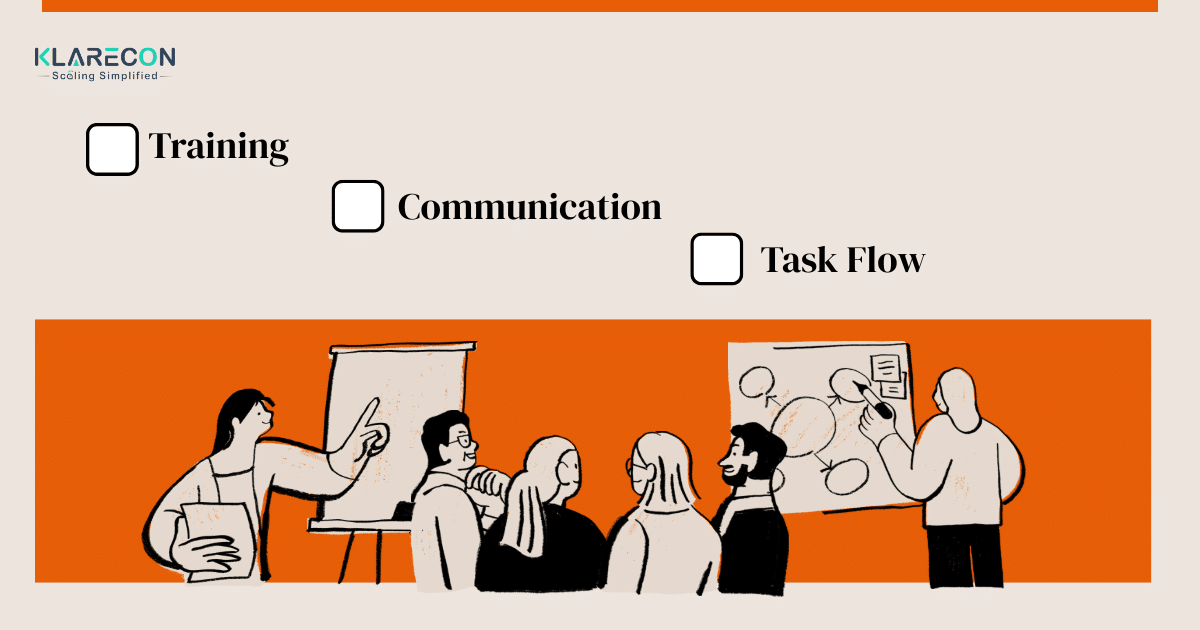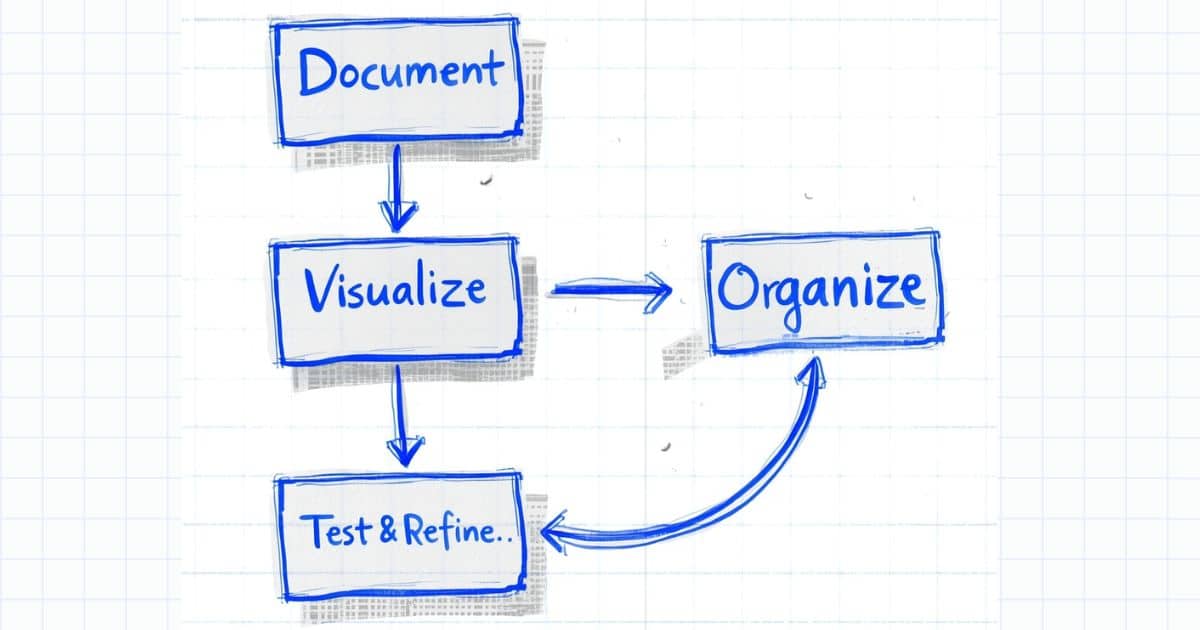
The aim of hiring a virtual assistant is to take some load off your desk and give you time to focus on more important things, but for that to happen, your VA needs to know exactly how you want things done. A VA’s skill and experience are not always enough, as you may have different preferences or operations from those they’ve worked with in the past.
SOPs for virtual assistants are like manuals that guide them through different aspects of working with you, like communication and task management. Without them, VAs will spend more time guessing and making mistakes or asking too many questions, but with them, you create a structure that reduces back-and-forths and allows your VA to work independently.
Every major aspect of your operations requires an SOP. If you don’t know where to start, this post will lead you in the right direction.
Core SOPs Every Business Should Create For VAs

Here are some Standard Operating Procedures for VAs that your business must have.
Communication SOPs
For clear communication, you should have SOPs that spell out how, where, and when communication should happen. They should include your preferred communication tools, response time, reporting structure, urgency guidelines, and everything that concerns the flow of information in your operations.
Some things to consider when setting up SOPs for communication are:
Communication Tools
Here, you’re looking at the right mix of channels that serve your communication needs. When you specify which tools you will use, messages aren’t scattered around, and you and your VA can always know where to check for specific messages.
At Klarecon, for example, we use Google Meet for daily meetings where managers share updates, such as targets, expectations, client updates, new methods, process changes, and other relevant information with other team members. In these meetings, our managers also answer questions from team members and address doubts shared by anyone regarding the work processes.
For task-based updates between team members, we use both WhatsApp and Monday, our project management tool. When the update concerns a task in progress, for example, an editor needs a fact checker to confirm new information provided by a writer, using Monday makes it easier for the fact checker to locate the document and work on it. However, if it’s a writer who is confused about how to approach an article, sending a message in the project’s WhatsApp group gives editors and other team members a chance to contribute and help them out.
Response Times
Having a set response time encourages a timely response from your VA. This response time will typically vary based on their roles or the urgency of the message. A VA assigned to managing projects may need to respond faster than someone scheduling posts on social media. While urgent requests may require attention within 15 minutes, general inquiries can often wait for an hour.
Reporting Structure
Working with multiple VAs who don’t report directly to you requires a structured approach to make sure communication can flow independently. Your VAs need to know how often they should report (is it daily or biweekly?) and how to format the report. You may require a checklist-style update where completed tasks are ticked and pending ones unmarked, or you may just want to see a short status update on your project management tool.
Your reporting structure also includes who receives messages and if they need to notify anyone after sending them. How each message is conveyed is also important. For example, quick updates via WhatsApp and detailed weekly reports via email. And don’t forget to include flags for tasks in your structure, so VAs can assign labels like “At Risk” or “Urgent” to tasks that require the attention of another team member.
Two aspects of our structure I find interesting are our daily reporting sheets and status updates on Monday.
Every day, associates fill in the tasks they have completed in a sheet before logging out. The sheet breaks down different aspects of tasks and is number-based, so when managers review it, they can easily quantify how much each team member accomplished.
Also, as a task passes between team members, e.g., from writers to fact checkers or fact checkers to editors, we use labels to show each team member and project managers the task’s status. You may see “Writing in Progress” on a task, which means a writer is currently working on it, or “Factual Errors,” which means a fact checker has checked the task and found claims that are incorrect or need more clarification.
This is just a peek into what work is like over here. The article, What It’s Like To Work At Klarecon, shares more about our working environment.
Task Management SOPs
Task management SOPs encompass everything from creating and assigning a task to its completion.
To avoid confusion, every task should follow a consistent process. Some details that are usually helpful when creating a new task include the title, description, priority level, deadline, and any supporting or sample links and files.
Progress should also be visible at every stage, so everyone concerned with a task, from project managers to other team members, can easily find updates on the task’s status without needing to ask. Every stage a task has to go through should be accommodated in the progress flow. Examples of such stages are “To Do,” “In Progress,” “Review Needed,” and “Completed.”
Finally, you have to define what “Done” means for each task. Is it when a document is submitted or when it is published? Spell it out. It goes without saying that a task file, which can be an image, a document, or a video, must be attached to every task before they are marked as completed or done.
Onboarding & Training SOPs
Do you want every new VA in your operations to start strong and adapt quickly? Your SOPs can make that happen. Begin with a clear introduction to your goals and workflows, and grant new hires access to all necessary tools and accounts. Also, provide task manuals or video walk-throughs to simplify learning and reduce confusion. Here’s a 4-step onboarding process to help.
Set a structured training schedule—by week three, for example, your VA should be able to handle routine tasks independently. Then, define how progress will be tracked and establish regular check-ins for feedback. When you cover these essentials, your VA will not only understand your processes faster but also be equipped to become productive and reliable much sooner.
Our new associates at Klarecon are exposed to an SOP that contains structured step-by-step documentation, live and recorded walkthroughs, peer shadowing for hands-on review, and demo tasks before real assignments.
When recorded walkthroughs are not enough, we conduct live walkthroughs to help further. We also do shadow sessions, where a senior associate reviews a new associate’s work in real time and provides hands-on assistance. Our managers monitor new associates throughout every step of the onboarding process to determine whether they are making progress or require additional training.
Examples Of Task-Specific SOPs For VAs
Besides core SOPs for virtual assistants, there’s another kind—task-specific SOPs. While the core ones focus on essential day-to-day functions, the task-specific ones are more concerned with detailed guidance for specific tasks. They result in efficiency and quality in areas like email management, social media, customer support, research, etc.
To better understand them, I’ll provide you with a couple of examples.
Email Management SOP
This SOP brings about efficient handling of emails in line with business priorities. The process may look like this:
Inbox Organization:
- Sorting: Immediately categorize incoming emails into designated folders such as Urgent, Client Queries, Internal Communication, and General.
- Tools: Use rules/filters in the email system to automate this sorting whenever possible.
- Expectation: Inbox should remain uncluttered, with unfiled emails not exceeding 10 at any given time.
Prioritization:
- Urgent Emails: Respond within two business hours.
- Standard Emails: Respond before the end of the business day.
- Low-Priority/Informational Emails: Review and address within 48 hours.
- Tip: Use flags or labels to indicate urgency levels.
Escalation Protocol:
- Criteria: Flag and forward emails that involve legal/financial matters or are outside your authority.
- Action: Forward to the appropriate manager within one business hour of receipt.
- Documentation: Note escalation in the email thread for transparency.
Follow-Up Tracking:
- Maintain a running checklist of pending replies, with deadlines noted.
- Review the checklist daily at the start and end of the day to prevent missed follow-ups.
Archiving & Deletion:
- Archiving: Move completed threads to the Archive folder immediately after closure.
- Deletion: Review and delete unnecessary emails (spam, redundant threads) weekly.
- Retention: Ensure important business communication is retained for a minimum of 1 year.
Invoice & Payment SOP
With an SOP for invoice and payment, a business can keep its financial records organized. Here’s what it may look like:
Invoice Creation:
- Template Use: All invoices must be generated using the approved company template.
- Required Fields: Include client name, invoice number, date, due date, description of services/products, and total amount due.
- Verification: Cross-check amounts and service descriptions against the signed contract or purchase order.
Review & Approval:
- Pre-Send Check: Review each invoice for accuracy in pricing, tax, and client details.
- Approval Workflow:
If the invoice value is under $5,000, the finance team can send it directly.
If the amount exceeds $5,000, get the manager’s approval before release.
- Documentation: Note the reviewer’s name and date of approval in the invoice log.
Sending Invoices:
- Method: Email invoices directly to the client’s billing contact using the designated company email account.
- Subject Line Standard: “Invoice #[Invoice Number] – [Company Name]”
- Timing: Send invoices on the last working day of the month unless otherwise specified in the contract.
Payment Tracking:
- Recording: Enter all sent invoices into the central tracking spreadsheet within 24 hours.
- Status Updates: Mark invoices as Pending, Paid, or Overdue.
- Bank Reconciliation: Verify incoming payments against invoice numbers and update records immediately upon receipt.
Follow-Up & Reminders:
- Initial Reminder: Send a polite payment reminder if the invoice remains unpaid 7 days after the due date.
- Second Reminder: If unpaid after 14 days, send a firm but professional follow-up that includes the outstanding balance.
- Final Notice: After 30 days, escalate the communication to management for further action.
Escalation Protocol:
- Criteria: Flag invoices that are more than 30 days overdue, disputed by clients, or consistently delayed.
- Action: Forward details to the Finance Manager along with all related correspondence.
- Resolution Options: May include direct client call, payment plan arrangement, or legal action (as per company policy).
Archiving & Record-Keeping:
- Storage: Save all invoices and proof of payments in the designated digital folder, organized by client and year.
- Retention: Maintain financial records for a minimum of 7 years for compliance and auditing purposes.
- Access: Only Finance and Management teams may access archived records.
How To Build Effective SOPs For Your VA
With all I’ve shared about SOPs, it’s easy to see how one may feel overwhelmed by the idea of creating one. To make it easy, I’ll show you how to create effective SOPs in a few easy steps.

Start With Documentation
First, you want to write down every step a VA has to follow in simple, easy-to-understand terms. The instructions should be organized step by step to avoid any confusion. Tools like Google Docs help, as they allow you to grant access to your VA and easily update the SOP.
It’s also a good idea to include a checklist for each task, so a VA can use it to determine if they’ve fulfilled all requirements before considering a task done. And finally, keep instructions simple and action-oriented. Here’s an example:
Instead of “Make sure the email is ready to go before sending it out.”
Go for “Open Gmail → Click ‘Compose’ → Paste the draft text → Add recipient’s email address → Attach the file → Click ‘Send.’”
Add Walk-Throughs
Text is helpful, but without a visual backup, it’s not enough for everybody. Some VAs still need to see the instructions come to life to fully understand them, and that’s where images and videos come in. Thankfully, tools like Google Docs allow you to attach screenshots of your processes, and Loom can host your video tutorials with shareable links that you can add next to the steps that require them.
It becomes easier to click “Compose” when a screenshot shows exactly where “Compose” is on the screen, and someone who has never attached files to an email will find it easy to do so for the first time if they can watch a video of someone else attaching files.
Organize & Assign
SOPs should also be easily accessible. Now that you’ve created the relevant SOPs for different tasks in your operations, store them all in the same location—maybe Google Drive or task management systems like Monday—then organize them according to the tasks they pertain to.
If, for instance, your operations involve filing reports and making social media posts, put the SOPs for filing reports under the project board for report filings. You can also consider attaching SOPs to every task, especially if each report has something unique.
When SOPs are well-organized, a VA can work independently, as they will be able to quickly locate the relevant SOP without having to search through the entire database.
Test, Refine, And Encourage Feedback
You may feel your SOP is flawless, but the only way to be sure is to put it through real-world testing. Have your VA follow your SOP exactly as it is documented, then watch out for areas where they face challenges. If you observe closely, you may find that some parts are confusing or inefficient.
Ask the VA for their thoughts and opinions after they’ve used it, and use their feedback to make it better. Then, repeat the process a few times over, and soon you will have something reliable. Remember that the VA is the one who gets to use the SOPs more, so their input should always be welcome. Encourage continuous feedback even when the SOPs are reliable enough.
SOP Templates For Virtual Assistants And Resources You Can Reuse
Before we wrap up, we’ll make things easy for anyone who wants to set up SOPs by providing a few resources. Here, you’ll find simple examples of checklists that you can adapt, free template libraries you can copy from, and how to adapt templates to your business.
Checklist Examples
Checklists serve as simple reminders of things to look out for before considering a task complete. Unlike SOPs, they don’t direct you on what to do, but help you confirm that nothing important gets missed. Here are some examples.
For Social Media Posting:
- Media attached
- Hashtags added
- Links tested
- Relevant accounts tagged
For Onboarding a New VA:
- Accounts and tool access granted
- SOPs and training materials shared
- Communication channels set up
- First-week tasks assigned
- Check-in schedule confirmed
Free Template Libraries
How To Adapt Templates To Your Business
Every operation is unique, so finding a template that fits your business perfectly is unlikely. It’s up to you to tweak it to fit. How do you do that? Let’s go!
First, thoroughly review the details of the template to see if it fits your process. Check the task steps, the tools, the deadlines, and the brand-specific requirements. You can also compare templates to select one that better suits your business needs.
As you review, remove any steps that don’t apply to your operations. A social media template may include creating a TikTok video, but if you don’t use TikTok, you don’t need it in your SOP, so delete it. This keeps the template simpler to edit as it isn’t cluttered with unnecessary information.
Now, go on to adjust the task data. If the template mentions Monday and you use ClickUp, edit it, and if their deadlines are 2 hours instead of your preferred 30 minutes, change that. Every tiny detail that differs from your business must be changed.
Don’t forget to include your brand-specific requirements, such as tone, visual style, formatting rules, and approval process. Also include any unique tasks or responsibilities that your VA will handle. The generic step may be “Check inbox and respond to emails,” but the specific task for your VA will be “Flag any influencer or partnership requests for manager review.”
Conclusion
Creating SOPs remains non-negotiable if you want to cut down time wastage and enjoy smoother operations. Now, you not only know what SOPs for virtual assistants look like and the different kinds you need, but also how to create yours.
Every task you systemize brings you closer to a smoother operation, especially when you step away. SOPs don’t have to be perfect, as they can be refined. Creating them sets the stage for greater efficiency, which also leads to higher productivity.
